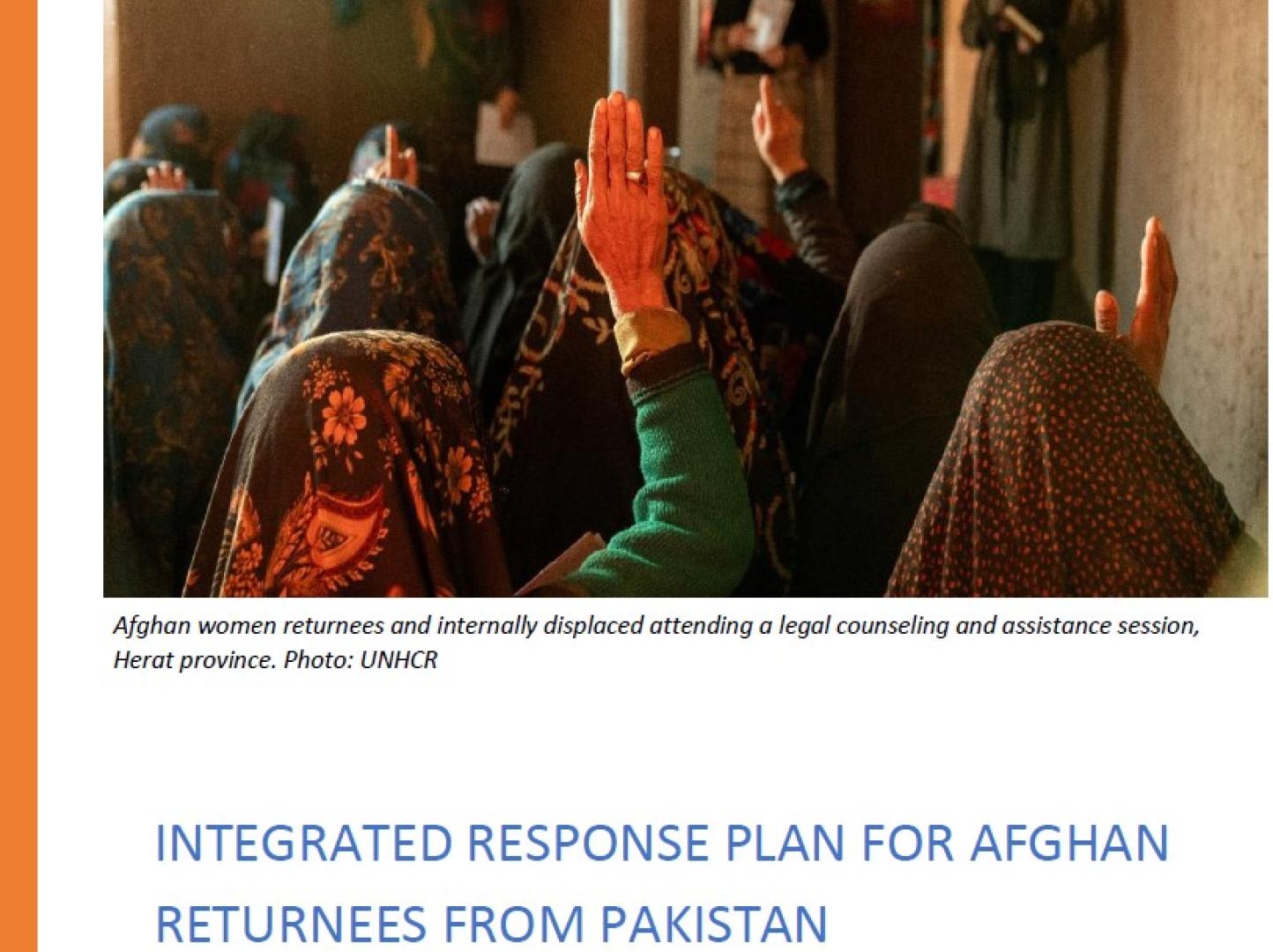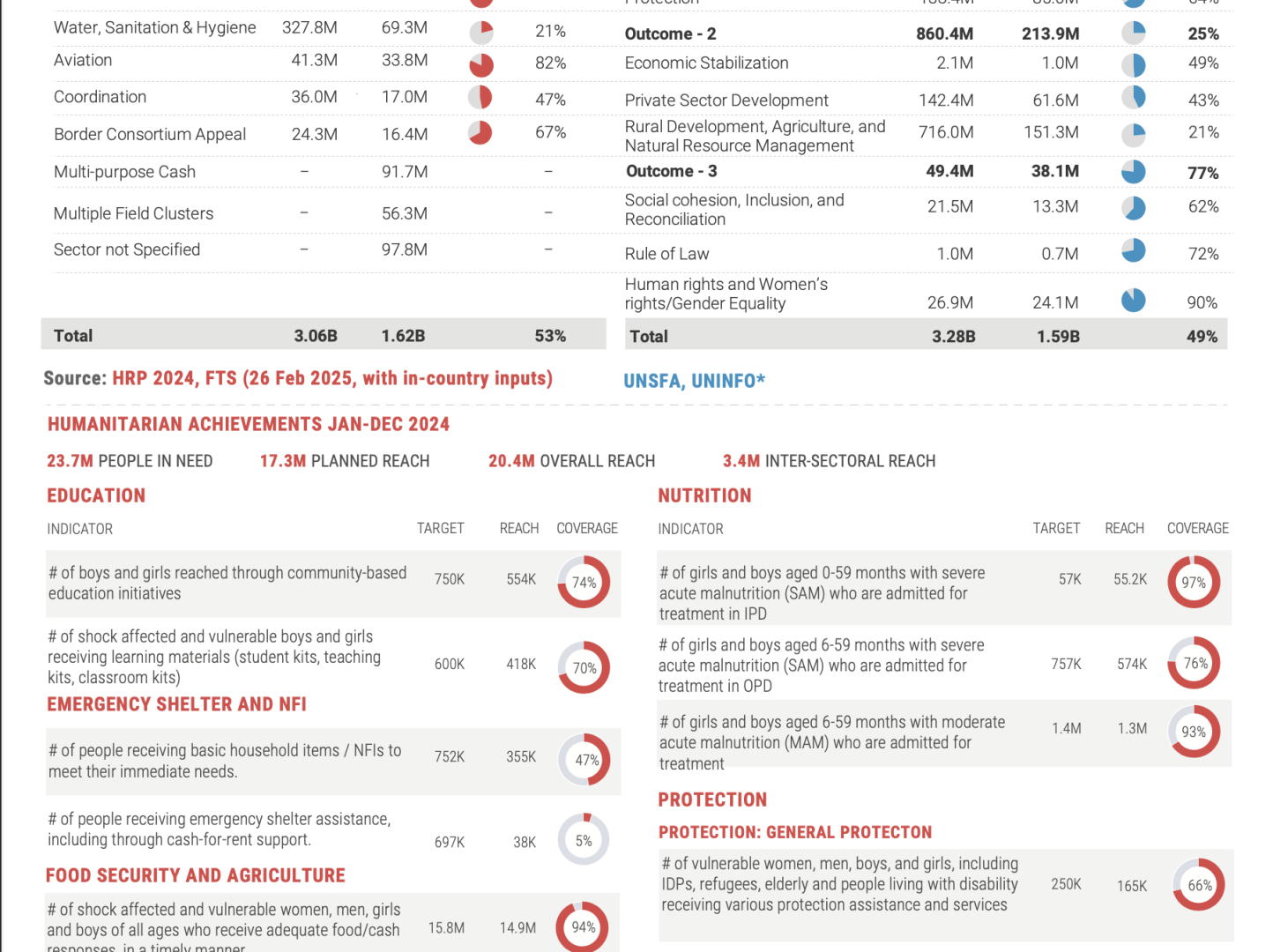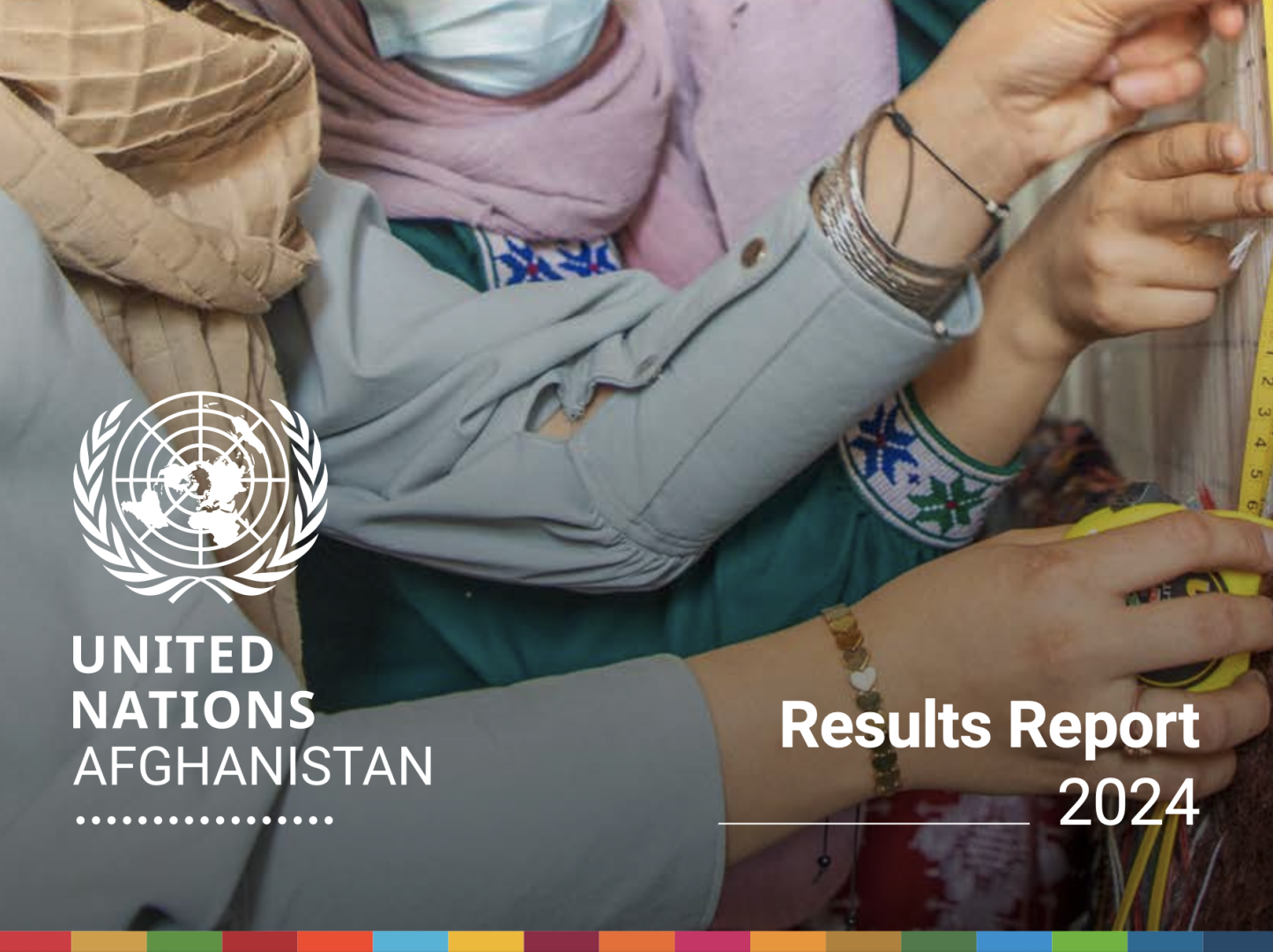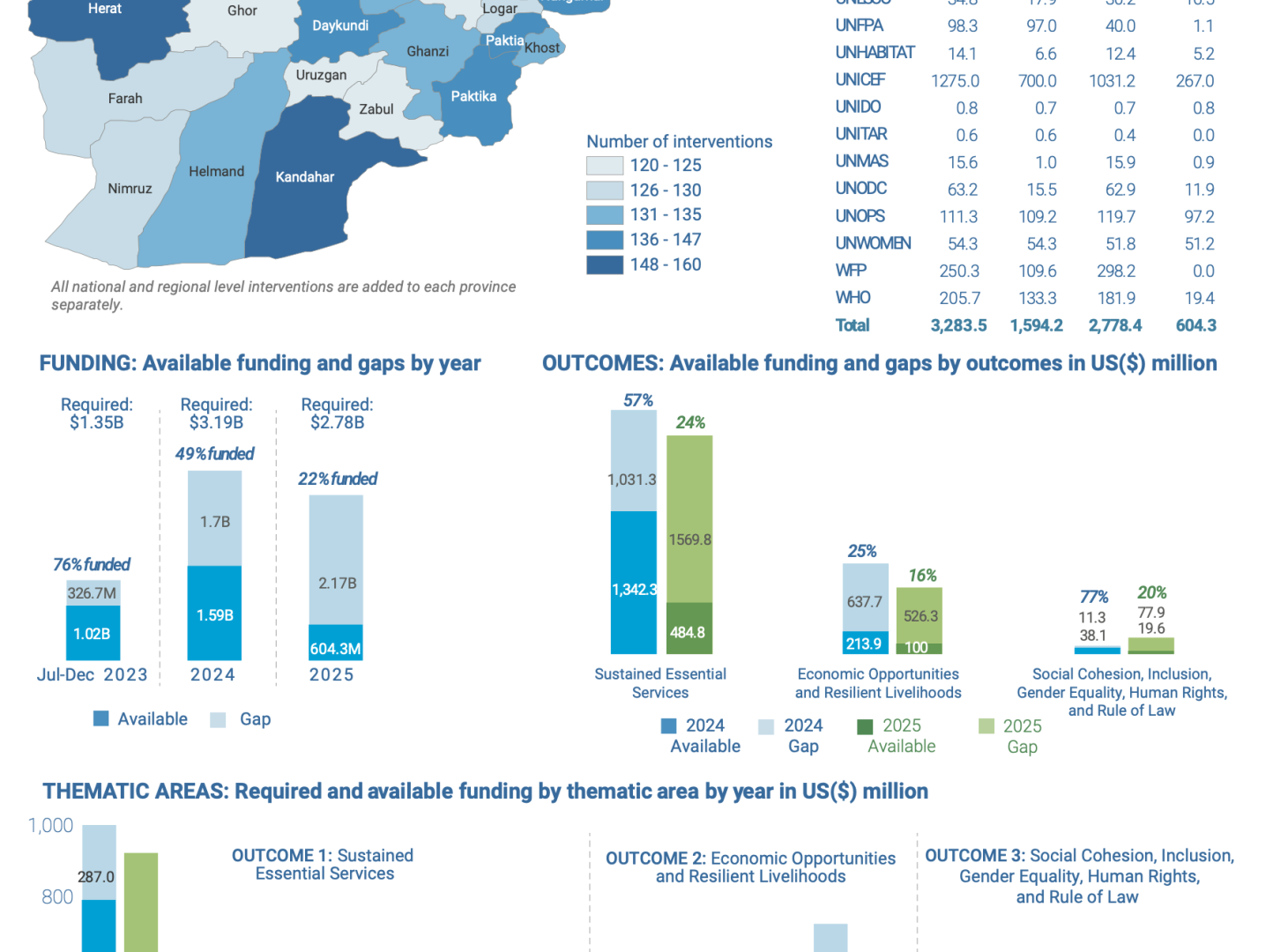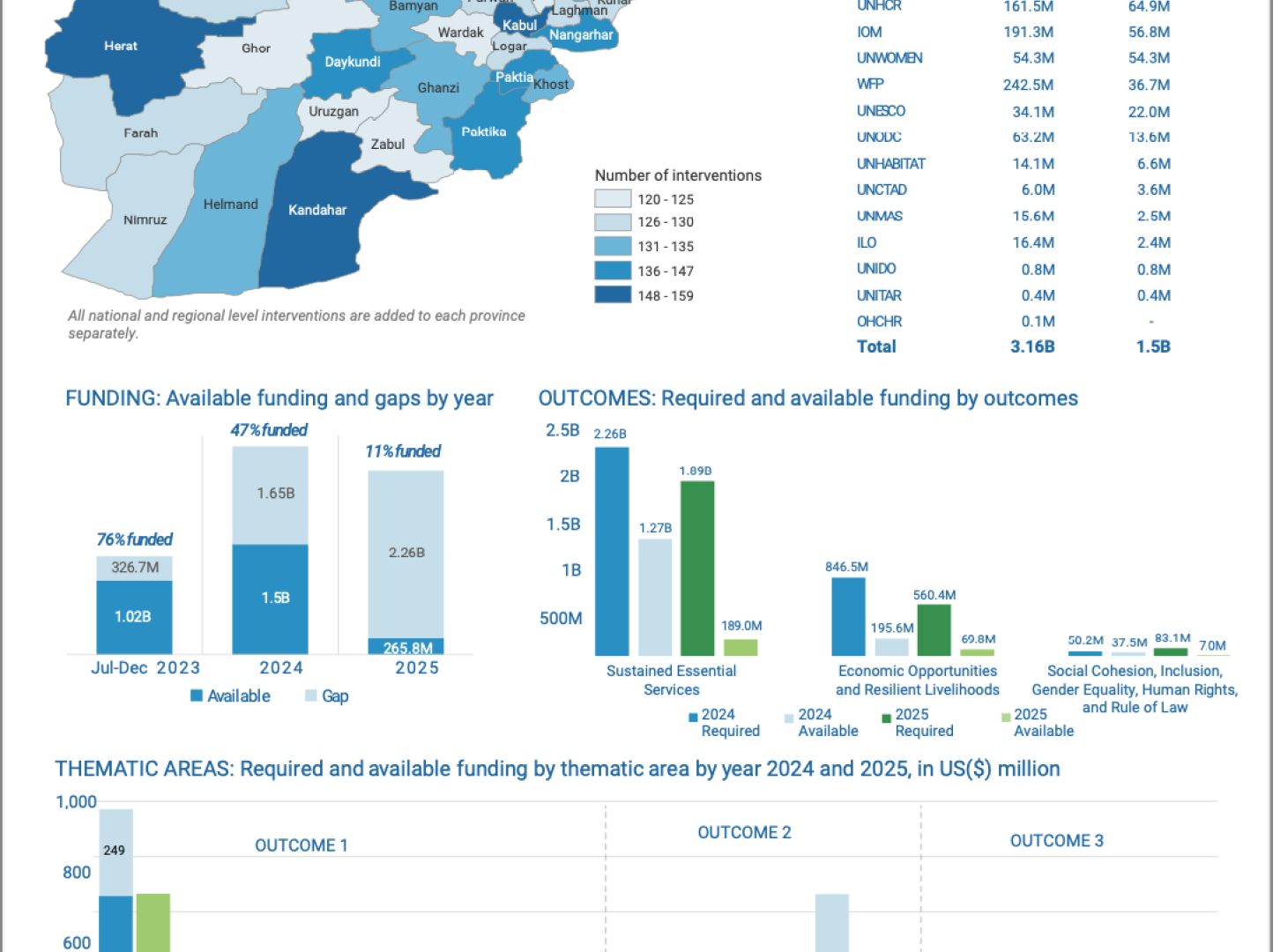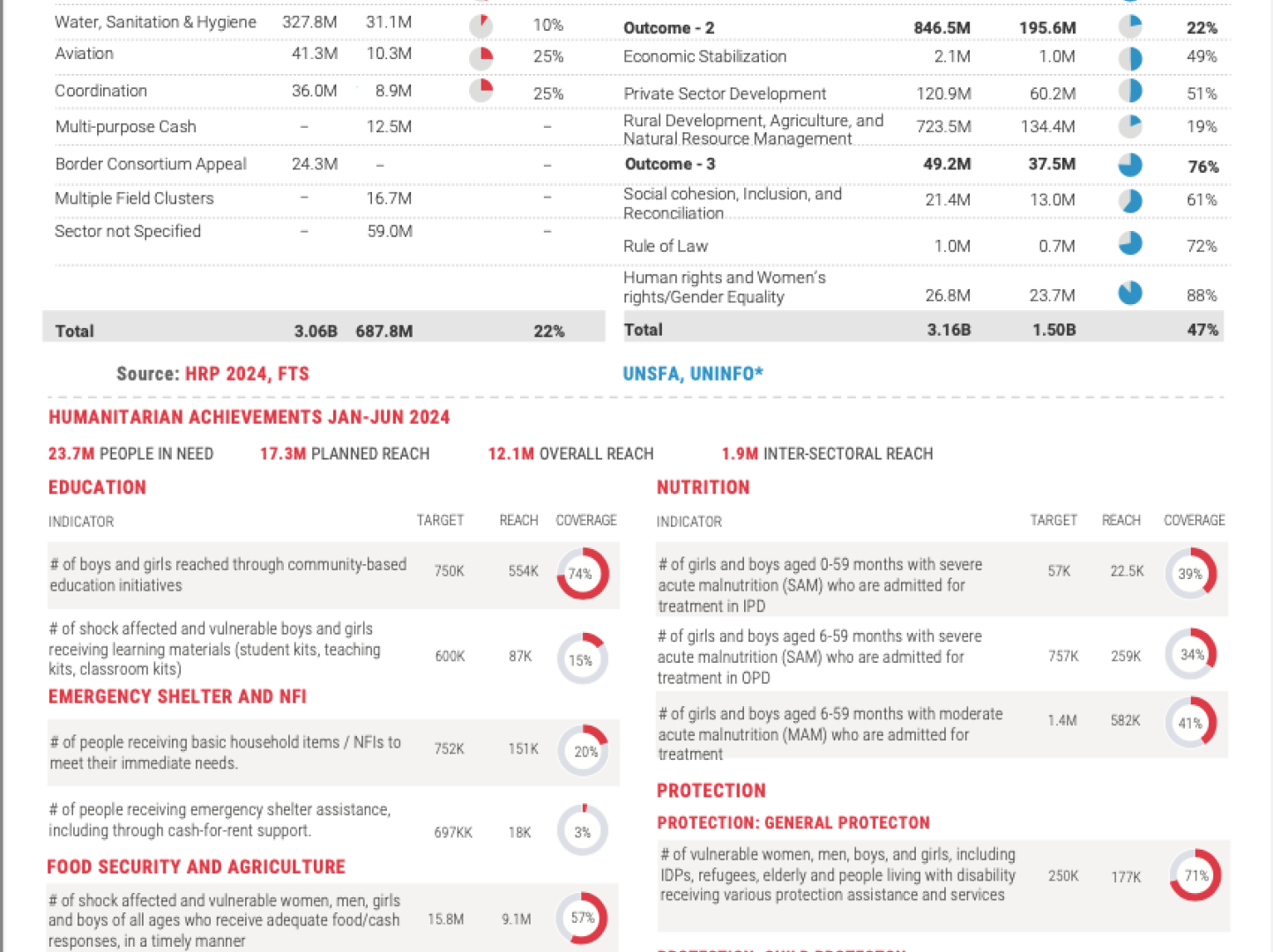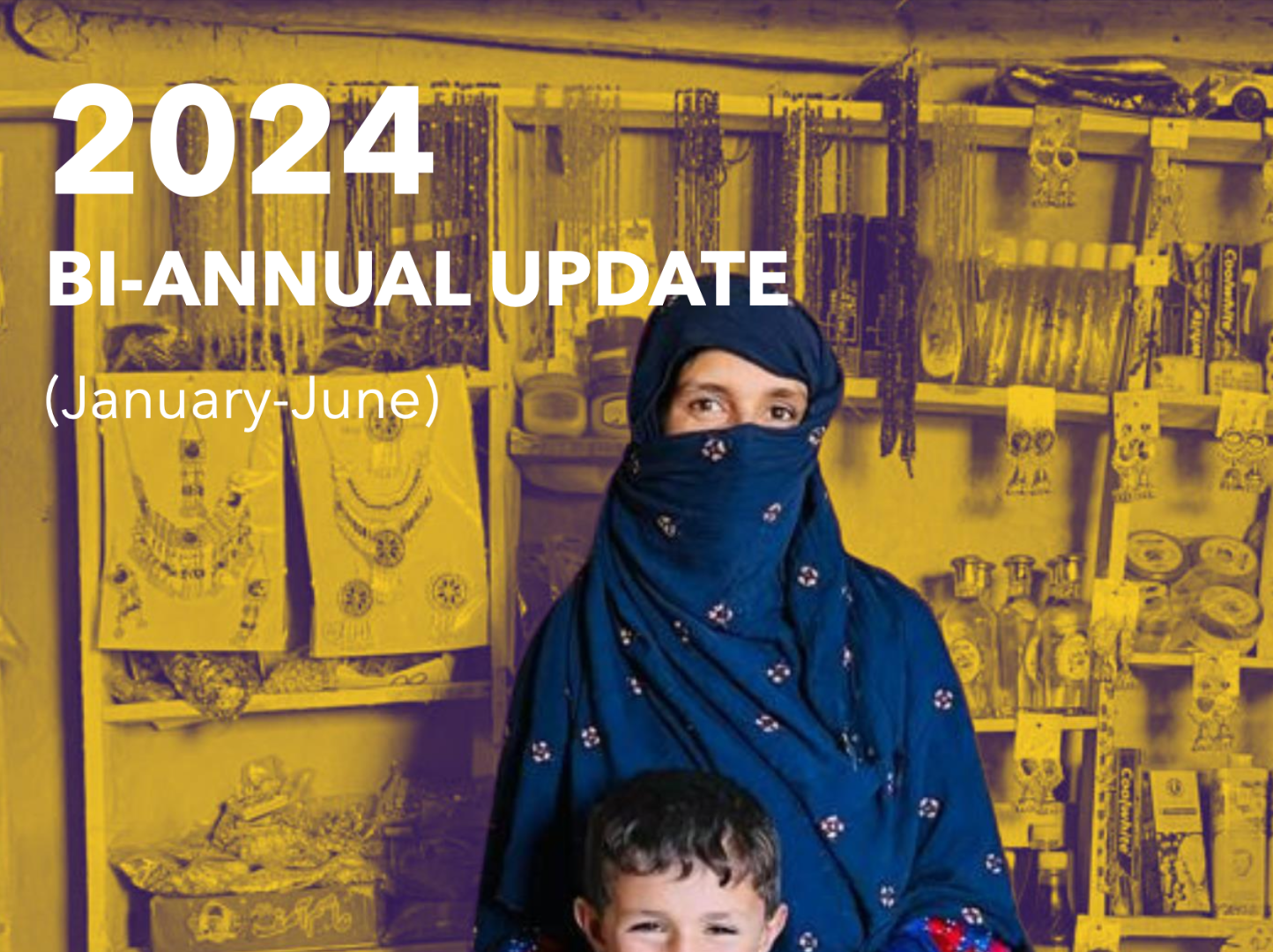Latest
Story
25 November 2025
Voices from Afghanistan’s Hunger Crisis
Learn more
Press Release
18 November 2025
Over 8 million children in Afghanistan reached as the second phase of the measles campaign concludes
Learn more
Story
04 November 2025
Building Disaster-Resilient Schools for Girls’ Education in Earthquake-hit Afghanistan
Learn more
Latest
The Sustainable Development Goals in Afghanistan
The Sustainable Development Goals are a global call to action to end poverty, protect the earth’s environment and climate, and ensure that people everywhere can enjoy peace and prosperity. These are the goals the UN is working on in Afghanistan:
Story
31 August 2025
Wakhan Corridor: UN and Partners Join Forces to Reach Afghanistan’s Most Remote Communities
The Wakhan Corridor in Afghanistan’s northeastern Badakhshan province is more than a breathtaking landscape – it is a region of strategic importance, and the United Nations, together with its partners, is committed to ensuring that no one is left behind, even in the most remote corners of Afghanistan. From 18 to 20 August 2025, the Deputy Special Representative of the Secretary-General, Resident and Humanitarian Coordinator (DSRSG/RC/HC) Indrika Ratwatte, visited Wakhan alongside Mr. Cenk Ünal, the Chargé d’Affaires of Türkiye in Afghanistan. The delegation met with local communities and de facto authorities, reviewed ongoing projects, and assessed the needs and priorities of the people. “The impact of the UN and its partners here is powerful, moving from emergency relief to building resilience and lasting community infrastructure,” said Mr. Ratwatte. “The Wakhan Corridor is not only beautiful, but also strategically vital for ensuring access to some of Afghanistan’s most remote communities. For years, its people were isolated and marginalized, but today our priority is making sure the most vulnerable are reached.”Working Together with CommunitiesCommunity engagement is at the heart of every initiative – ensuring that local people feel ownership of the projects and services that directly affect their lives. “Türkiye stands with the people of Afghanistan, including in its most remote and hard-to-reach areas. The Wakhan Corridor shows how important it is for the international community to work together to bring services, education, and livelihoods closer to the people,” said Mr. Ünal.Agriculture and livestock are the main sources of income in Wakhan. Over the years, UN-supported projects – such as irrigation systems, watershed construction, forestry programmes, nutrition, healthcare, and education – have improved lives and livelihoods. But challenges remain. The rugged terrain, frequent landslides, flash floods, and harsh winters isolate Wakhan for more than half the year, cutting communities off from the rest of Badakhshan province. “Winters last more than six months here,” explained Mohammad Ibrahim, a local elder. “During this time, we are cut off, unable to travel, and face great hardship.”Education and Hope for the FutureDespite the difficult conditions, children in Wakhan walk for hours across the mountains to reach school. However, ongoing restrictions on girls’ education have left many young women without opportunities.“But we still hope. Life skills education and vocational training projects can open new doors,” shared 29-year-old Anis Gul during a meeting with the UN delegation. She and others in the community called on the UN and its partners to support women and girls with practical training and resources to generate income and build sustainable livelihoods. Building Alternative LivelihoodsAs part of its counternarcotics efforts in the country, the UN is working closely with farmers to promote alternative livelihoods in Wakhan. These efforts include distributing certified seeds, improving irrigation, creating orchards, and building greenhouses. “Our aim is to ensure farmers have sustainable alternatives,” said Mr. Ratwatte. “Alongside this, we are expanding healthcare, drug treatment services, and vocational training programs for women and girls, empowering them to support their families and strengthen their communities.”
1 of 5

Publication
17 September 2025
UN Afghanistan Factsheets, Jan - June 2025
The Factsheet (January to June 2025) centers on the results achieved with UN-supported interventions for the period January to June 2025, responding to the humanitarian and basic human needs of people in Afghanistan.
1 of 5

Publication
21 September 2025
UNSFA Funding Dashboard - Jan - June 2025
UNSFA Funding Dashboard, January - June 2025
1 of 5

Publication
02 May 2024
INTEGRATED APPEAL FOR AFGHAN RETURNEES FROM PAKISTAN (BORDER RESPONSE AND REINTEGRATION RESPONSE IN AREAS OF RETURN)
The Government of Pakistan’s “Illegal Foreigners’ Repatriation Plan – I” (IFRP-I) that came into effect on November 01, 2023, resulted in a mass return, both voluntary and forced, and deportations of predominantly undocumented Afghans living in Pakistan to their home country. From September 15, 2023, to April 15, 2024, more than 553,000 Afghans returned to their country of origin, including 447,000 undocumented individuals, 11,000 Afghan Citizen Card (ACC) holders, and 83,000 Proof of Registration (PoR) card holders, along with other documented Afghans such as asylum seekers or slip holders, issued by UNHCR and its partners in Pakistan. On March 18, 2024, the Government of Pakistan announced the intention to launch a second phase of the IFRP (IFRP-II), to commence on April 15, 2024, targeting the repatriation of the remaining undocumented and documented Afghans, including ACC holders and those registered with UNHCR and its partners in Pakistan. This announcement was made despite concerns from legal experts’ over possible violations of the decree of non-refoulement principles under international law. The UN estimates project another 901,000 Afghans will return to Afghanistan between April 16 to December 31, 2024. However, on April 26, 2024, the Government of Pakistan extended the validity of 1.3 million PoR cards for Afghan refugees living in Pakistan up to June 30. Given the pattern of large-scale systematic human rights violations and discrimination against women and girls in Afghanistan, the impact on women and girls deported back to Afghanistan could be severe. To help alleviate the impact of the forced returns, the United Nations and partner NGOs in Afghanistan are launching this Integrated Appeal to respond to emergency needs of returnees at border crossing points (Border Response) as well as recovery interventions in the priority Areas of Return (AoR) to meet the medium- to long-term needs of returnees and host communities (Reintegration Response), using a joined-up nexus approach between the humanitarian and durable solutions efforts. Author: United Nations and Partner NGOs in Afghanistan For queries contact:(Ms) Izora Mutya Maskun at imaskun@iom.int for Border Response (Ms) Farhana Stocker at fstocker@unicef.org for Reintegration Response Plan
1 of 5

Publication
04 April 2025
2024 UN Afghanistan Annual Results Report
Looking back at the past three years, the trajectory of assistance to Afghanistan highlights the immense adaptability and unwavering commitment of aid partners towards the Afghan people. Despite complex challenges, our collective effort—supported by generous donor contributions and the steadfast engagement of International Financial Institutions (IFIs)—have remained focused on addressing urgent needs while laying the groundwork for long-term resilience and stability. In 2022, aid partners mobilized over US$3 billion in humanitarian assistance to stabilize the country and meet critical needs. The adoption of the United Nations Strategic Framework for Afghanistan (UNSFA) in 2023 marked a pivotal shift towards a more strategic approach, enabling a gradual transition from emergency relief to sustainable solutions that address the root causes of vulnerability.Building on this foundation, in 2024, we championed a joined-up approach among UN agencies, funds, and programmes (AFPs) and our partners. This integrated coordination model strengthens the linkages between humanitarian assistance, basic human needs, and peace efforts. By enhancing operational coordination and advancing strategic initiatives, we have sought to complement political engagement efforts, including the Doha Process. As part of this endeavour, we expanded targeted consultations with donor partners, IFIs, relevant de facto authorities (DFA), civil society, the private sector—including women-led Micro-, Small, and Medium- Enterprises (MSMEs)—and think tanks.Our strategic direction aligns with the recommendations of the Special Coordinator’s Independent Assessment, UN Security Council Resolution 2721, the Afghanistan Coordination Group (ACG) Framework, the UNSFA, and the Humanitarian Needs and Response Plan (HNRP). These guiding frameworks reinforce our commitment to a principled, needs-based, and sustainable approach to assistance. Our interventions not only address immediate humanitarian and basic human needs but also complement the ongoing Doha Process by fostering dialogue, stability, and mutual understanding.In 2024, I visited 13 provinces to build trust, assess ground realities, and engage directly with communities, key stakeholders, and the DFA. These visits have been instrumental in shaping our interventions and ensuring that our work remains informed by the needs and aspirations of the Afghan people.Stories like Meryem, a female entrepreneur who returned from Pakistan to establish a successful clothing business in Kabul; Sumaya the young girl in Herat, determined to continue her education while scaling up her tailoring company with a grant; and community elders championing literacy classes for women showcase the tangible impact of our collective efforts. Similarly, flood protection walls funded through the Special Trust Fund for Afghanistan have safeguarded lives and livelihoods, underscoring the importance of sustained investment in resilience-building measures.None of these achievements would be possible without the extraordinary generosity of donor partners and the critical support of IFIs. Their unwavering commitment has enabled us to implement impactful programmes that not only meet immediate needs but also foster long-term economic stability and social resilience.As we look ahead, I invite all partners to reaffirm our shared commitment to sustaining the minimum investment necessary to strengthen the resilience of Afghans. By continuing our collaboration, we can hel ensure that Afghanistan remains on a path towards stability, dignity, and self-reliance for all its people. Indrika RatwatteDeputy Special Representative of the Secretary-General, Resident and Humanitarian Coordinator (DSRSG/RC/HC)
1 of 5

Story
25 November 2025
Voices from Afghanistan’s Hunger Crisis
Hunger in Afghanistan is escalating rapidly, making it one of the world’s most severe hunger crises and ranking fourth globally for child acute malnutrition. As winter approaches, malnutrition among women and children - already at record highs - is expected to spike further. Behind this crisis are stories – of families who can no longer take their daily meals for granted, of children battling malnutrition, and of mothers who look around their homes and find nothing to feed their children. The needs are immense – but WFP’s resources are shrinking. Among those facing the harsh realities of this crisis is Toor Jan, whose story reflects the daily struggle of millions across Afghanistan.In Baghran District of Helmand Province, Toor Jan lives with his extended family in a region long affected by conflict and poverty. He is the sole provider for a large household, including four brothers and two sisters who suffer from physical disabilities and mental health issues. Toor Jan’s mother is bedridden and needs constant care, while he also looks after his five children.His brother occasionally finds casual work, but the income is barely enough to buy bread. The family’s needs are overwhelming, and the burden falls mostly on Toor Jan.Helmand is one of the most food-insecure provinces in southern Afghanistan. Many families face acute hunger, and some must choose who gets to eat each day. In this difficult environment, WFP’s emergency food assistance is the only hope for some of the most vulnerable families in the region. Toor Jan’s family receives monthly food assistance from WFP. This support helps him meet basic food needs and allows him to focus on caring for his family. Far from Helmand, in the mountainous reaches of Bamyan Province, another story of resilience unfolds—that of Ruqia.Ruqia is 18 years old. After her father passed away, her mother remarried and no longer stays with Ruqia’s family. As the eldest sibling, Ruqia has taken on the responsibility of caring for her two younger brothers. She lives with her siblings in a remote district perched high in the mountains – Waras district of Bamyan province. Life here is shaped by the altitude, and winter doesn’t wait for the calendar date, it arrives early, often before the rest of the country has even felt the winter chill.She said: “We are not prepared at all for the cold.” With snow likely just weeks away, her family faces the harsh season with little protection. This is Ruqia’s second time receiving WFP’s assistance, helping her meet the family’s basic needs.Assisting families like Ruqia’s and countless others would not be possible without generous contributions from our partners like the Asian Development Bank (ADB), Australia, Canada, the United Nations Central Emergency Response Fund (CERF), EU Humanitarian Aid, France, Germany, Greece, Iceland, Japan, New Zealand, Private Sector, Russia, Sweden, Switzerland and the United Kingdom. In addition, thanks to the Republic of Korea for their contribution of rice towards WFP operations in Afghanistan. Learn more about WFP’s work in Afghanistan: Afghanistan | World Food Programme (wfp.org)By: Ziauddin Safi - Ziauddin.safi@wfp.org
1 of 5

Story
04 November 2025
Building Disaster-Resilient Schools for Girls’ Education in Earthquake-hit Afghanistan
On 7 October 2023, a series of powerful earthquakes struck Herat, Western Afghanistan, claiming thousands of lives, destroying homes, roads, and schools—critical infrastructure that once connected and gave hope of a better life for Afghan communities. Among the damaged buildings was Chahar Dara High School, where 9-year-old Sunbul, a third grader who dreams of becoming a teacher, studied. For Sunbul, going to school was a constant fear, but still, she continued to attend classes. “There were cracks everywhere, in walls, in the roof, in hallways, and everywhere,” she recalls. “It made me feel unsafe, and I was not able to focus on my lessons.”Herat’s harsh, windy climate, locally called 120-day winds, worsened the situation, leaving Sunbul and her classmates exposed to various hazards. “Windows were broken,” she says. “On windy days, dust filled the classroom, and I could hardly breathe.”For Sunbul and hundreds of other students, the earthquake didn’t just crack walls, it disrupted their access to safe and available education. Without functioning buildings, toilets, or drinking water taps, being at school and learning became nearly impossible. Rebuilding these structures became a high priority to restore normalcy after the earthquake. Echoing Sunbul’s thoughts, her teacher, Ms. Tahira Roshan, commented, “The earthquake created a distressing sight and raised fears among students in the schools.” Acknowledging the anxiety felt by their parents, she continued, “I observed that many families were concerned about their children’s safety at school.”Hope returned when UN-Habitat, with support from the Special Trust Fund for Afghanistan (STFA), launched a school rehabilitation project in Herat. Through this initiative, eight earthquake-hit schools were repaired, and six new ones are under construction — providing safer learning spaces for more than 16,800 students, both girls and boys – every year.The project prioritized earthquake- and climate-resilient construction, improved ventilation, and used local labor and materials, creating jobs for affected families and fostering community ownership of the schools.“When I first entered the new classroom, it was pure delight,” Sunbul says with a bright smile. “The classroom was rehabilitated, the walls were freshly painted, the fan was running, lights were working, and the blackboard looked perfect. It finally felt like a real classroom.”Renovations also included new toilets and handwashing facilities, which, after the earthquake were unusable, and are now improving hygiene, protecting students’ health. Also, the schools’ rooftops are renovated with new climate-resilient materials like isogam (an anti-moisture and humidity insulator), to prevent rain leakages. Today, Sunbul and her classmates feel both safe and motivated to attend school. “The classrooms are now safer, and everyone feels encouraged to continue their lessons,” she explains. “I always wanted to enjoy my time with classmates and teachers—and now I can.”Looking towards the future, Sunbul dreams of becoming a teacher. “I will not give up my dream. I will keep on trying – and my school gives me hope.”Ms. Tahira, expressing her positive thoughts about the change she has seen in the school since completion of repair works, said: “I have noticed a remarkable improvement in student attendance, with students coming to class regularly. The future of any community depends on the quality of education and achieving that requires a safe and supportive environment.”, thanking the STFA and UN-Habitat, she said.“Building disaster-resilient schools is a crucial step towards advancing the inclusive recovery process in earthquake affected-areas and fostering hope for a better tomorrow of Afghanistan,” says Ms. Stephanie Loose, Country Programme Manager, UN-Habitat Afghanistan. “Afghan girls are being excluded from many parts of public life. Through rebuilding schools, but also improving their living conditions, we stand with them and support their rights in every possible way,” she added. Note: Names (Sunbul and Tahira) are pseudonyms used to protect the individuals’ privacy.
1 of 5

Story
12 October 2025
Rebuilding in earthquake-hit Afghanistan
“It was close to midnight when the ground shook,” recalls Suliman, a farmer from Shumash, a village in the Afghan province of Kunar. “It felt like Judgment Day. People were screaming, homes were collapsing, and in an instant, we lost everything - our families, our fields, even our animals.”On the night of 31 August 2025, a 6.0 magnitude earthquake struck eastern Afghanistan near the border with Pakistan. Violent aftershocks triggered landslides and blocked roads, cutting off remote communities still reeling from heavy rains and years of hardship.In Suliman’s village, home to nearly 800 families, not a single house remains habitable. Some are hosted under tents in open fields; others moved to temporary camps. Suliman says most families had 10 to 15 animals. Now, they are left with just two or three.“Many were crushed under rubble or swept away by landslides. Without them, we lose not just food, but also the little income we had,” he says.Further south, in the province of Nangarhar, Habibullah surveys the ruins of his village, Atran.“The earthquake destroyed everything,” Habibullah says. “Our maize fields are damaged, the water channel is in ruins, and even the fruit trees have dried up. Our animals died too; their shelters are destroyed. With winter coming, we fear losing the few that remain.”Like with Suliman and Habibullah, the earthquake struck communities already facing years of drought, seasonal floods and economic hardship. For returnee families, who had only just come back with little to start over, the disaster has been especially harsh. Even before 31 August, nearly 950 000 people in these provinces were projected to face acute food insecurity. That figure is now expected to rise sharply. Rapid responseIn a region where agriculture and livestock are lifelines, the emergency responses have to be fast and focused.Within days of the earthquake, teams from the Food and Agriculture Organization of the United Nations (FAO) conducted rapid assessments. Speaking directly with affected communities, water access emerged as the most urgent need.Irrigation canals were destroyed or blocked by debris, leaving families without safe drinking water, let alone water for crops or animals. FAO began clearing and restoring canals, racing against time to save standing summer crops like maize and beans that require one last irrigation for a good harvest this month.Beyond the 445 km² of irrigated farmland now at risk, over 500 000 animals face health threats. Stored feed was contaminated by debris, and animal shelters were destroyed. Families who once relied on maize, wheat, beans, rice, milk and meat now struggle to feed their children.Communities appealed for help to restore veterinary services, rebuild animal shelters and restock feed and livestock.In response, FAO and its network of private Veterinary Field Units (VFUs) are treating and vaccinating surviving animals, which remain vital sources of food and income. As of 29 September, FAO has treated 1 163 animals to prevent disease outbreaks. VFUs have also safely disposed of more than 5 600 animal carcasses in the worst-hit districts of Kunar, preventing zoonotic disease outbreaks and water contamination. FAO teams trekked for hours through mountainous terrain, navigating landslides and debris to reach remote villages.“It takes about three to three and a half hours on foot to reach the site and bury the animals,” says Shamsher, a livestock keeper in Kunar. “But FAO teams are here, helping us.”In addition, planned cash-for-work programmes will employ local labourers to rebuild livestock shelters—putting money directly into families’ hands and stimulating the local economy. Rush for winter harvestWith winter only weeks away, families have a narrow window to prepare their land and protect their animals. Missing this opportunity could mean no harvest next year - and deeper hunger well into 2026.FAO has appealed for USD 23.4 million to ensure these communities have the lifesaving, emergency agricultural assistance they require to cover their basic needs.Meanwhile, a Joint United Nations Rapid Needs Assessment is underway to quantify the damage and losses and guide recovery. FAO is leading the agriculture component, drawing on its technical expertise and deep community presence to assess losses in crops, livestock and irrigation systems.Every day counts to protect food, livelihoods and dignity for farming families who have already endured so much.The rapid response activities to date have been made possible thanks to the generous support of the United Nations Central Emergency Response Fund (CERF) as well as FAO's Special Fund for Emergency and Resilience Activities (SFERA).
1 of 5
Story
31 July 2025
A new oxygen facility at Kabul’s children's hospital cuts child mortality rates
Kabul, Afghanistan – The new oxygen plant – the result of a partnership between the World Health Organization (WHO) and the European Union (EU) –at the Indira Gandhi Institute of Child Health (IGICH) in Kabul is giving Afghan children a better chance at life. Opened on 6 May 2025, the plant is already making a major difference.It can produce up to 210 oxygen cylinders a day, enough to meet the needs of the hospital and support nearby health centres. For a facility that once depended on unreliable oxygen deliveries, this is a game changer.“There were times when oxygen delivery trucks came late,” said Dr Naimullah Safi, head of IGICH Intensive Care Unit (ICU). “We lost many children during those waiting hours. Children who could have been saved if oxygen had arrived just a bit earlier.”Families were sometimes asked to find oxygen on their own. It was stressful, costly, and heartbreaking for those who couldn’t afford it. Now, the ICU has a steady oxygen supply piped directly to the bedsides. Other departments, like the emergency and cardiac wards, also benefit from the plant thanks to large oxygen balloons that store and distribute the gas where it’s needed.Abdurahim, a father from Parwan province, shared his story: “My 4-year-old son was in the ICU for 8 days with measles and a serious lung infection. He needed oxygen the whole time. The doctors and nurses cared for him so well and with oxygen available he recovered. We are so thankful. It saved his life.”Since the plant opened, the hospital has seen a 30% drop in ICU deaths. It has also saved money by reducing the need for outside oxygen suppliers. And extra oxygen is now being shared with other hospitals in Kabul during emergencies."The oxygen plant, funded by the European Union, stands as a clear testament to the EU's unwavering commitment to the health and well-being of the Afghan people. We are confident it will save countless lives of children," said EU Chargée d’Affaires in Afghanistan Veronika Boskovic Pohar.IGICH medical director Dr Khaibar Sahak notes that “the oxygen plant doesn’t just serve the Indira Gandhi Children’s Hospital but is also helping other major hospitals like Wazir Akbar Khan, Afghan-Indonesia and Shaikh Zayed”.WHO Representative in Afghanistan Dr Edwin Ceniza Salvador explained the broader impact. “This oxygen plant is saving children’s lives every day. Doctors can now give the right care when it’s needed and families no longer have to worry if oxygen will arrive on time. This is a major step forward for child health in Afghanistan.”Funded by the EU, the oxygen plant is an example of how solid partnerships and smart investments are helping build a more robust health system in Afghanistan, starting with its youngest and most vulnerable patients.
1 of 5
Story
27 July 2025
Breaking the barriers to hepatitis care in Afghanistan
Kabul, Afghanistan – Hepatitis B is preventable through vaccination, and highly effective and affordable treatments for both hepatitis B and C are now available in generic form. Yet the World Health Organization (WHO) reports that mortality related to hepatitis B and C virus infections is the only instance where deaths from a communicable disease are increasing globally. WHO has set global targets for elimination of the diseases. But in Afghanistan, where years of instability have taken a toll on the health system, hepatitis B and C often remain invisible. The diseases don’t always show clear signs at first, meaning many people live with them for years without knowing. By the time they do find out, it’s often too late.Take 52-year-old Bibi Maryam from Gardiz, Paktia province. She thought her constant tiredness and stomach pain were just stress. “I never imagined it was something serious,” she said, lying on her bed at the National Infectious Disease Hospital in Kabul. “I didn’t even know what hepatitis B was.”What saved Bibi was access to free testing and treatment at the hospital in Kabul. “They treated me with kindness and explained everything. I feel better now,” she said. Widespread misconceptions and a lack of public awareness result in many individuals seeking medical care only after the disease has progressed to a critical stage. To combat hepatitis effectively, there is an urgent need for education, early detection and proactive health care.According to reports by the Afghanistan National Programme for control of AIDS/HIV, STI and Hepatitis (ANPASH), in the first 3 months of 2025, 936 247 people were tested for hepatitis B and C across the country.From 2023 through the first quarter of 2025, more than 67 230 people tested positive for hepatitis B (37 604 men and 29 626 women), and 27 937 cases of hepatitis C were confirmed (14 276 men and 13 661 women). “Hepatitis is a life-threatening and highly infectious disease that is too often ignored,” said Dr Said Adil Niromand, a specialist at the National Infectious Disease Hospital in Kabul. “Most people don’t seek help until it’s too late.”ANPASH is starting to change that. Supported by WHO and other partners, ANPASH has expanded testing, improved care, trained health workers on the latest guidance and is improving access to new, highly effective medication.“We’re seeing more cases every year,” said head of the ANPASH programme Dr Abdur Rahman Shirindil. “We’ve made significant progress under challenging conditions, but to sustain this progress and move closer to eliminating hepatitis in Afghanistan continued support is essential.”“Too many lives in Afghanistan are lost to hepatitis, not because we can’t treat it but because it is often found too late,” said WHO Representative in Afghanistan Dr Edwin Ceniza Salvador. “We’re working closely with national health teams to make early detection and treatment easier to access, especially for those who need it most. But we can’t do it alone. We call on all partners to stand with Afghanistan in breaking down the barriers so that no one suffers or dies from a disease we can prevent and treat.”Bibi’s story is just one among many. It shows how access to testing and treatment saves lives. Without ongoing support from international partners, more lives, including those of women and children, will be lost. Let’s break the silence. Let’s remove the barriers. Let’s stop hepatitis – together. For more information:Dr Malyar Kareemzai, HIV Treatment OfficerANPASH/MoPHm_kareemzai@yahoo.com Modaser Islami, Communication OfficerWHO Afghanistanislamim@who.int
1 of 5
Press Release
18 November 2025
Over 8 million children in Afghanistan reached as the second phase of the measles campaign concludes
The 10-day second phase, which started on 29 October, reached 8 355 446 children aged 6 months to 10 years with one dose of the measles vaccine across 17 hot-weather provinces, achieving 91.7% coverage of the more than 9 million children targeted. In addition, 3 953 961 children aged 0 to 10 years received one dose of bivalent oral polio vaccine across 5 provinces in the south and one province in the southeast. Building on the first phase of the nationwide measles campaign – completed in October this year after reaching 8.3 million children across 17 cold-climate provinces – Afghanistan is advancing efforts to ensure immunization of all children.The campaign was launched in response to continued measles outbreaks and low routine immunization coverage. The Afghanistan Multiple Indicator Cluster Survey (MICS) 2022–2023 found that only 51% of children had received their first measles dose, and just 37% their second dose. The successful rollout of the campaign has helped close these critical immunity gaps, laying the foundations for identifying missed children and strengthening routine vaccination as the country works towards measles control. “The roll out of the second nationwide drive to protect another 9 million Afghan children demonstrates the commitment of WHO, Afghanistan’s health authorities, partners and communities to protect children from preventable diseases,” said WHO Representative in Afghanistan Dr Edwin Ceniza Salvador. “Reaching 91.7% of target children is a major achievement, but our work continues as we must reach every child, especially in the hardest-to-reach areas. WHO remains dedicated to closing immunity gaps and ensuring no child is left behind.”“The conclusion of this second phase marks another important step in protecting Afghanistan’s children from a disease that should never cost a young life,” said UNICEF Representative in Afghanistan Dr Tajudeen Oyewale. “Reaching millions of children in every type of community is only possible because families, health workers and partners came together with one purpose: to keep children safe. UNICEF will continue supporting all efforts to strengthen routine immunization and ensure that every boy and girl receives the vaccines they need to grow up healthy.”With the successful completion of both phases of Afghanistan’s nationwide measles campaign, over 16.6 million children have now been protected against this deadly but preventable disease. This achievement reflects the dedication of Afghanistan’s health authorities, the tireless efforts of WHO, UNICEF and NEPI, and the generous support of Gavi. Together, they are strengthening routine immunization services and closing immunity gaps, helping to ensure that no child is left behind.# # #For media inquiries, please contact:Ajyal SultanyHead of Communications, WHO AfghanistanE-mail: sultanya@who.int Daniel TimmeChief of Communication, UNICEF Afghanistan E-mail : dtimme@unicef.org
1 of 5
Press Release
21 October 2025
EU Increases humanitarian funding to expand WHO’s health response in Afghanistan
The extra funding will help WHO expand its emergency health response, with a focus on delivering lifesaving services to underserved communities and returnees across the country. According to the Afghanistan Humanitarian Needs and Response Plan 2025, 14.3 million people face limited access to essential health care due to underfunded services, facility closures and a shortage of female health workers. As Afghanistan continues to face complex humanitarian challenges, including natural hazards, displacement and disease outbreaks, maternal health, trauma care and disease prevention are urgent priorities. EU support will allow WHO to enhance surveillance of infectious diseases through the deployment of surveillance support teams (SSTs), improve the supply of medical materials and strengthen coordination for the returnee response. “This additional contribution from the EU helps ensure that no one is left behind – even in the most remote or crisis-affected areas,” said WHO Representative in Afghanistan Dr Edwin Ceniza Salvador. “It reinforces the principle that access to health is a right, not a privilege.” The original EU-funded project supports a comprehensive package of health services, including the operation of 41 primary health care centres, 4 maternity hospitals and 2 emergency trauma centres at the Torkham and Spin Boldak border crossings. It provides mental health and psychosocial support services through 4 acute mental health wards, treatment for severe acute malnutrition in 19 inpatient facilities and training for 26 midwives to tackle the shortage of female medical professionals in rural areas. “When an earthquake struck eastern Afghanistan last August, affecting nearly half a million people, WHO was immediately present on the ground. Thanks to EU support and contributions from other partners, WHO rapidly deployed emergency health teams to the affected areas to provide trauma care to those in need,” added Dr Salvador. “We remain committed to supporting the resilience of Afghanistan’s health system during these challenging times. Through our partnership with WHO, we are ensuring vital health services reach those most in need, especially in remote, disaster-affected and underserved areas. This support prioritizes maternal and child health, mental health, trauma care, nutrition and disease preparedness,” said Head of the EU's Humanitarian Aid Office in Afghanistan François Goemans. WHO Afghanistan extends its thanks to the EU for its continued support which strengthens our commitment to work closely with partners and humanitarian actors to ensure coordinated, inclusive and accountable health service delivery across the country.For media inquiries, please contact:Ajyal SultanyHead of Communications, WHO AfghanistanEmail: sultanya@who.int Lisa Hastert Regional Information Officer, EU Humanitarian Aid Asia/PacificEmail: Lisa.Hastert@echofield.eu
1 of 5
Press Release
08 October 2025
Afghanistan reaches 8.9 million children in the first phase of a nationwide measles campaign
Measles is one of the most contagious diseases and a leading cause of vaccine-preventable deaths among children. In Afghanistan, where access to routine immunization is limited and many children face challenges like malnutrition, measles can lead to serious health complications, including pneumonia, blindness and even death.In 2024, over 9300 measles cases were reported. By August 2025, another 8500 cases had been reported. The number of outbreaks also increased, rising from 127 in 2023 to 430 in 2024. Nearly 92% of cases were in children under 10 years of age. Prior to the nationwide vaccination campaign, only 55% of children had received their first dose of the measles vaccine, and just 44% had received a second dose. These gaps in coverage left many children unprotected, allowing the disease to spread. Afghanistan is committed to eliminating measles. Vaccination efforts and high immunization coverage are vital to achieve this goal, protect communities and prevent future outbreaks, both locally and across borders.“Measles is a deadly but preventable disease, and in a country like Afghanistan, where too many children are vulnerable, vaccination is a lifeline,” said WHO Representative in Afghanistan Dr Edwin Ceniza Salvador. “The successful completion of phase 1 of this nationwide campaign marks a vital step in protecting millions of children from illness, disability and death. We are deeply grateful to the tireless health workers, volunteers and partners who made this effort possible, often in the most challenging conditions. WHO remains firmly committed to supporting Afghanistan’s health system to ensure that no child is left behind.”“No child in Afghanistan should die from a disease we know how to prevent. Measles is not only a deadly disease but also an alarm bell for gaps in immunization coverage and health equity. Every outbreak reveals where children have been left behind,” said UNICEF Representative to Afghanistan Dr Tajudeen Oyewale. “The success of the first phase of the nationwide vaccination campaign is an important step forward, but now our focus must turn to closing immunity gaps and integrating this effort into routine immunization. With stronger systems, equitable access and unwavering resolve, we can protect every child in Afghanistan from preventable diseases like measles.” The 2-phase nationwide campaign has been tailored to achieve at least 95% coverage among children aged 6 months to 10 years, identify and vaccinate children missed in previous rounds and strengthen routine immunization services for long-term protection.With the conclusion of the first phase, WHO, UNICEF and partners remain in close coordination with national health authorities to consolidate progress and prepare for the next phase of the campaign, ensuring that no child is left behind.# # # For media inquiries, please contact:Ajyal SultanyHead of Communications, WHO AfghanistanE-mail: sultanya@who.int Daniel TimmeChief of Communication, UNICEF Afghanistan E-mail : dtimme@unicef.org
1 of 5
Press Release
08 September 2025
Over 35 metric tonnes of WHO medical supplies arrive in Kabul to support earthquake survivors in eastern Afghanistan
The newly arrived cargo, mobilized through WHO’s logistics hub in Dubai, includes trauma and emergency surgery kits, primary health care kits, noncommunicable disease kits and essential medicines. These supplies will be dispatched to health facilities and mobile health teams in the hardest-hit areas, following the ongoing needs assessments. This will enable doctors and nurses to provide urgent treatment, perform emergency surgeries and help prevent the spread of disease.The earthquake left a path of destruction across Kunar, Nangarhar and Laghman provinces, killing more than 2200 people, injuring 3600, and destroying almost 6800 homes. Tens of thousands of families remain displaced, while 20 health facilities have been damaged and referral hospitals continue to struggle with hundreds of trauma patients. “The loss and suffering caused by this earthquake is immense,” said Dr Edwin Ceniza Salvador, WHO Representative to Afghanistan. “These additional medical supplies are a lifeline for families who lost everything and for health workers who continue to serve tirelessly despite being affected themselves. Every day counts in saving lives, and WHO will remain side by side with health partners to ensure affected communities get the care they urgently need.”WHO has been on the ground from the first hours of the crisis, deploying mobile health teams, psychosocial support services and disease surveillance systems. The arrival of this latest airlifted shipment strengthens those efforts and ensures that essential health services continue at a time when communities need them most.WHO’s emergency operations have been made possible through the generous support of donors, including the Afghanistan Humanitarian Fund (AHF), European Union Humanitarian Aid and others. However, sustained funding will be critical to expand and maintain lifesaving interventions for those who need it most.# # #For more information, please contact:Ajyal Manssour Al-SultanyHead of Communications, WHO Afghanistan- KabulE-mail: sultanya@who.int
1 of 5
Press Release
25 August 2025
WHO Afghanistan receives vital support from OCHA to strengthen health services
Of this support, the CERF allocation of US$ 4.98 million as part of its underfunded emergencies window will allow WHO to operate 42 primary health care centres (PHCs), deploy 15 surveillance support teams (SSTs) and procure and deliver 249 primary health care kits to 13 provinces. The AHF grant of US$ 1.39 million will support 6 sub-health centres, 10 SSTs and 13 inpatient therapeutic feeding centres, providing lifesaving care for children suffering from severe acute malnutrition (SAM) in 4 provinces with the greatest needs.The CERF and AHF contributions arrive at a time when Afghanistan’s health system faces severe pressure, with almost 1 in 3 people unable to access even the most basic care. “WHO welcomes the CERF and AHF allocations which will help prevent avoidable deaths, strengthen our ability to respond to disease outbreaks and reach vulnerability communities at high risk, especially women and children affected by economic and environmental crises, forced returns and displacement. Together, these funds make it possible for WHO to expand its reach and serve more people in more places,” said WHO Representative in Afghanistan Dr Edwin Ceniza Salvador.The combined projects will directly benefit more than 747 000 people, while improving outbreak control measures will indirectly benefit an additional 2.4 million through enhanced health infrastructure."WHO's work is extremely important in Afghanistan where both CERF and AHF have facilitated the scaling up of its lifesaving interventions," said Deputy Head of OCHA Afghanistan Kate Carey. "These vital allocations come at a time when an unprecedented number of Afghans are returning from the Islamic Republic of Iran and Pakistan, and large parts of country face the prospect of severe drought.”Backed by CERF and AHF, the projects will strengthen Afghanistan's health system by bringing essential primary health care to vulnerable communities, ensuring timely treatment for children suffering from malnutrition and improving disease surveillance and outbreak response. These essential services aim to prevent illness and save lives, particularly in communities where access to health care is often too distant or hard to reach.***For media inquiries, please contact:Nourhan El-NagdyDonor Visibility Officer, WHO Afghanistan
Email: elnagdyn@who.int Phone: +93 78 365 5635 Katherine CareyDeputy Head of Office, OCHA AfghanistanE-mail: carey2@un.orgTel: +93 79 300 3700 Abdullah ZahidPublic Information Officer, OCHA AfghanistanE-mail: abdullah.zahid@un.orgTel: +93 79 300 3200
Email: elnagdyn@who.int Phone: +93 78 365 5635 Katherine CareyDeputy Head of Office, OCHA AfghanistanE-mail: carey2@un.orgTel: +93 79 300 3700 Abdullah ZahidPublic Information Officer, OCHA AfghanistanE-mail: abdullah.zahid@un.orgTel: +93 79 300 3200
1 of 5
Latest Resources
1 / 11
Resources
30 June 2025
1 / 11

























